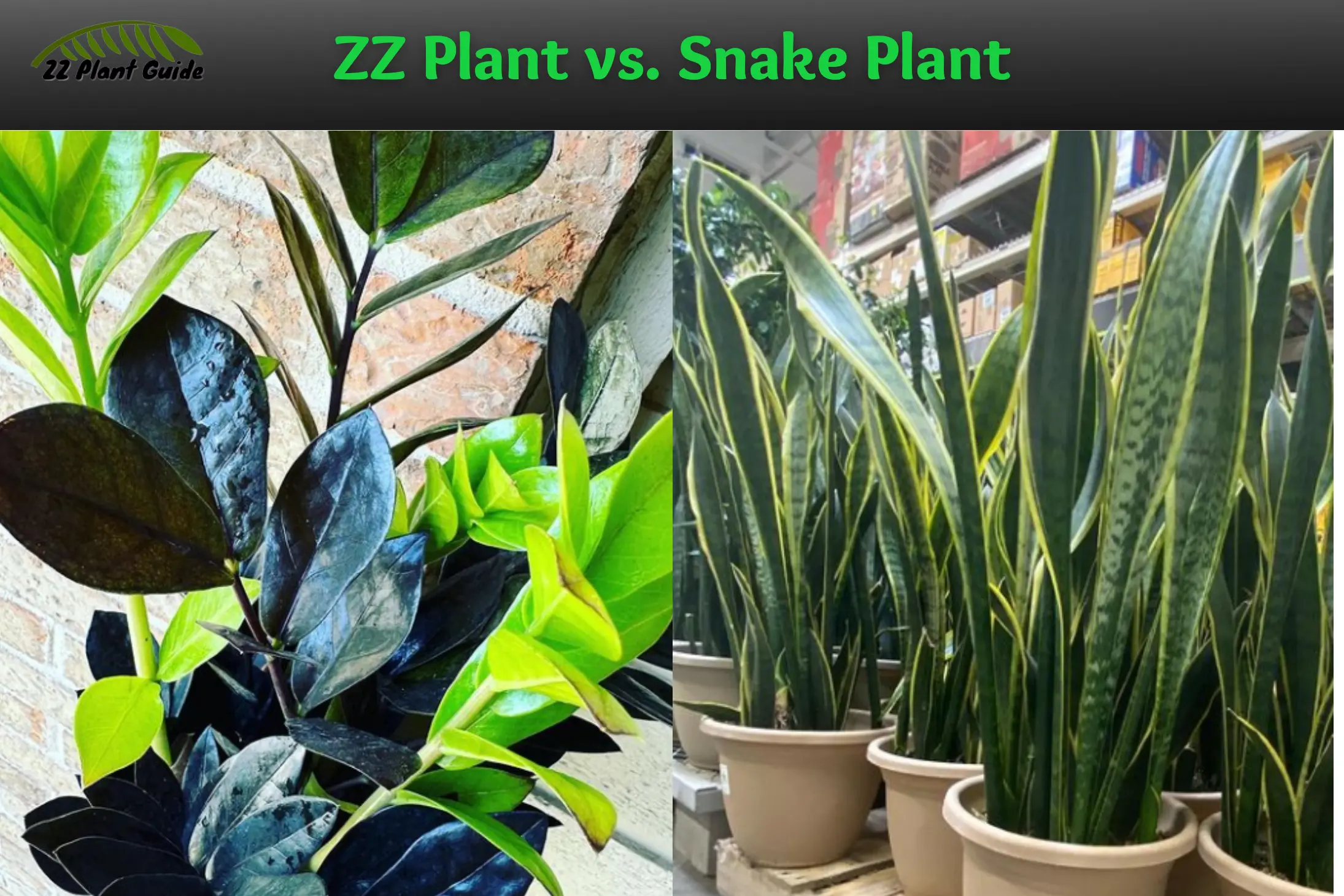Welcome to today’s epic botanical showdown! Today, we’re pitting two of the most popular, low-maintenance, and hard-to-kill indoor plants against each other: the ZZ plant and the Snake plant.
So grab some popcorn, sit back, and enjoy as we dive into an in-depth, lighthearted exploration of these two green titans.
ZZ Plant vs. Snake Plant
The ZZ Plant
Scientific name: Zamioculcas zamiifolia
In the green corner, hailing from the tropical regions of eastern Africa, we have the ZZ plant! This glossy, leafy warrior can withstand serious neglect and still come out swinging.
The ZZ plant is a master of survival, thanks to its rhizomes (think potato-like structures) that store water for those times when you “accidentally” forget to water it for, you know, months.
The Snake Plant
Scientific name: Sansevieria trifasciata
In the slightly-less-green corner, coming from West Africa, we’ve got the Snake plant. This spiky, upright contender is also known as the “Mother-in-Law’s Tongue,” but don’t let that scare you!
The Snake plant is a true champion when it comes to surviving in less-than-ideal conditions, and it won’t hold a grudge if you don’t water it every day.
Maintenance and Care
Watering
ZZ Plant: Water? What’s that? The ZZ plant is like that friend who can go days without drinking water and still be perfectly fine. You only need to water your ZZ plant once every 2-3 weeks or when the soil feels dry to the touch. Be careful not to overwater, or your plant’s roots may rot.
Snake Plant: The Snake plant is also part of the “low-water” club. Watering every 2-6 weeks (depending on the season) should keep this tough guy happy. Again, be sure not to overwater or leave it standing in water, as root rot is a real party pooper.
Lighting
ZZ Plant: The ZZ plant is like that one friend who can’t decide if they’re an introvert or an extrovert. It can handle low light, but it will also thrive in bright, indirect light. Avoid direct sunlight, though, as it can scorch the leaves.
Snake Plant: The Snake plant is the ultimate introvert. It loves low light conditions and will grow just fine in a dim room. However, it can also tolerate bright, indirect light. Direct sunlight? No, thanks.
Soil and Fertilizer
ZZ Plant: The ZZ plant prefers well-draining soil to avoid drowning its roots. You can use a general-purpose potting mix, but adding some perlite or sand will help drainage. When it comes to fertilizer, a balanced, water-soluble fertilizer every 4-6 months will keep your ZZ plant satisfied.
Snake Plant: Like the ZZ plant, the Snake plant also enjoys well-draining soil. A mix of potting soil, sand, and perlite works wonders. Fertilize with a balanced, water-soluble fertilizer every 4-6 weeks during the growing season (spring and summer) and every 8-10 weeks in fall and winter.
Growth and Propagation
Growth
ZZ Plant: The ZZ plant is a slow-grower, but it can eventually reach up to 2-3 feet tall. It’s perfect for those of us who are a bit impatient and want to see some progress, but not so fast that it takes over your living room.
Snake Plant: The Snake plant is also a slow-grower, but it’s got some height aspirations. Depending on the variety, it can grow anywhere from 8 inches to 12 feet tall. It’s perfect if you want to add some vertical interest to your space without the need for a ladder to care for it.
Propagation
ZZ Plant: You can propagate ZZ plants by dividing the rhizomes, taking leaf cuttings, or rooting stem cuttings. No matter which method you choose, it’s pretty simple and will give you baby ZZ plants to share with friends (or hoard for yourself, no judgment here).
Snake Plant: Snake plants can be propagated through division, leaf cuttings, or even by planting the offsets (baby plants) that grow at the base of the mother plant. It’s like a little plant family reunion!
Health Benefits and Air Purification
Health Benefits
ZZ Plant: ZZ plants are said to help reduce stress and boost your mood, thanks to their lush, green leaves. Plus, they’re a great conversation starter when friends come over and marvel at your green thumb.
Snake Plant: Snake plants are known to improve indoor air quality by removing toxins like formaldehyde, benzene, and xylene. Plus, they release oxygen at night, making them a great choice for bedrooms to help you get a good night’s sleep.
Air Purification
ZZ Plant: The ZZ plant isn’t a top air-purifying plant, but it does contribute to improving indoor air quality. It’s not an all-star, but it certainly helps out!
Snake Plant: The Snake plant is a true air-purification superstar! It’s one of the top plants recommended by NASA for improving indoor air quality. It’s like having a little oxygen factory in your home.
Pet and Kid Safety
Toxicity
ZZ Plant: Uh-oh! The ZZ plant is toxic to both pets and humans if ingested. Keep this one out of reach of curious little hands and paws.
Snake Plant: The Snake plant is also toxic if ingested. Like the ZZ plant, it’s best to keep this one away from kids and pets.
The Verdict
So, who’s the winner in this epic battle of the indoor greenery? Honestly, it’s a draw. Both the ZZ plant and Snake plant are low-maintenance, hardy, and visually appealing. They each have their unique characteristics and benefits, so it all comes down to personal preference.
If you’re a fan of lush, green leaves and a plant that forgives your forgetfulness, the ZZ plant might be your ideal match. On the other hand, if air purification and a striking, upright appearance are your priorities, the Snake plant could be your new best friend.
FAQs
Absolutely! Both ZZ plants and Snake plants can handle the humidity of a bathroom, making them great options for adding some greenery to your bathroom space. Just make sure they receive some natural light, even if it’s indirect.
Both plants are excellent choices for beginners, thanks to their low-maintenance nature and ability to tolerate neglect.
If you’re looking for a plant that can survive in low light and doesn’t require frequent watering, either plant would be a great starting point for your indoor plant journey.
While both ZZ plants and Snake plants are generally pest-resistant, they can sometimes fall victim to common houseplant pests like spider mites, mealybugs, and scale insects.
To keep your plants pest-free, check them regularly for signs of infestation and treat promptly if you spot any critters.
ZZ plants and Snake plants are slow-growing, so they don’t need repotting very often. Generally, you can repot them every 2-3 years or when you notice the roots becoming crowded in their current pot.
When repotting, choose a container with drainage holes and use well-draining soil.
ZZ plants typically come in one main variety, but you may encounter the rare ‘Raven’ variety, which has dark, almost black leaves.
Snake plants have a wider range of varieties, including:
Sansevieria trifasciata ‘Laurentii’: Yellow-edged leaves
Sansevieria trifasciata ‘Moonshine’: Silvery-green leaves
Sansevieria cylindrica: Cylindrical, braid-like leaves
Sansevieria trifasciata ‘Twist’: Twisted, vertically-striped leaves
Sansevieria trifasciata ‘Black Gold’: Dark green leaves with yellow edges
These are just a few examples, and there are many more interesting Snake plant varieties to discover!




